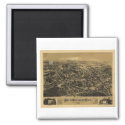Part of the
National Park Service's
Teaching with Historic Places Lesson Plans, the website
Carnegie Libraries: The Future Made Bright is replete with fascinating information about one of the 20th Century’s most intriguing figures, Andrew Carnegie.
It is probably safe to say that most anyone reading this will have visited a library at some time in their life. According to the American Library Association (ALA) there are an estimated 123,129 libraries of all kinds in the United States today. Between 1886 and 1919, Carnegie’s donations of more than $40 million paid for 1,679 new library buildings in communities large and small across America. About thirty-six Carnegie libraries exist in New Jersey, where I live.
It is probably safe to say that there are millions of visits to currently operating Carnegie libraries in the United States every year. In 2004, over one million people visited the Carnegie Library in Pittsburgh alone. The impact of Carnegie is immeasurable.
The National Park Service (NPS) has developed a wonderful site for use as a lesson plan for educators that detail the history and contributions of Carnegie and his libraries. For those unfamiliar with the history of the libraries, the NPS website serves as a simple introduction.
Before Carnegie, the public library system suffered from a lack of money and resources, insufficient book collections, and limited memberships. Buying books and building libraries were, for most citizens, a low priority. The generosity of Andrew Carnegie accelerated the development of American libraries. His donations provided communities across the country with millions of dollars to build new libraries.
The site gives a sample of the form used for applying for applying for a Carnegie grant, examples of Carnegie libraries and background history, samples of library building plans, and detailed information on the Carnegie libraries in Medford (WI), Connellsville (PA), Richfield (UT), Spokane (WA), and Girard (KS).
Why the National Park Service you may ask? They are the focus of the NPS because many of the Carnegie libraries are listed in the National Register of Historic Places.
Visit the site and gain a deeper appreciation for these wonderful places!
WEBSITE [http://www.nps.gov/history/Nr/twhp/wwwlps/lessons/50carnegie/50carnegie.htm]
 [LIB3668]
[LIB3668]











































